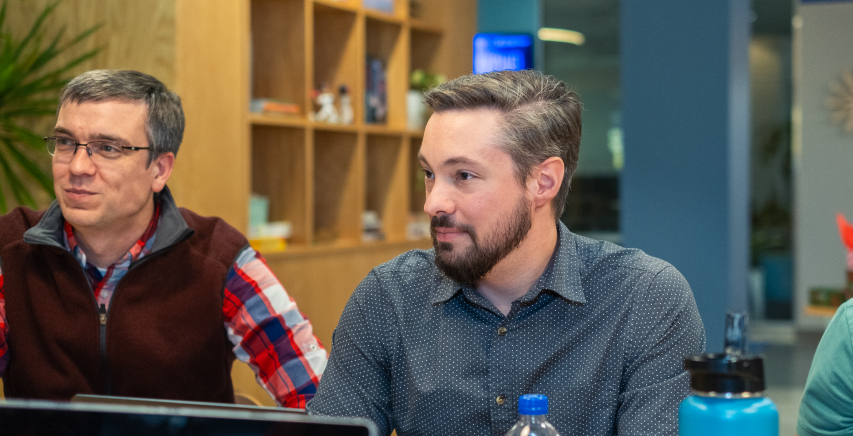Daniel: Welcome back to Web6 this season. We are talking about how to navigate the website project process. I’m Daniel Cowen.
Chris: And I’m Chris Lafay.
Daniel: And today we’re going to be talking about content. The content on your website, falls into a few different categories, mainly the words on the screen, the photos, and videos that are gonna be used throughout your site. And some content would include other media assets, but mainly those are the top three.
Who is providing content?
Chris: And one of the things you want to get right with content at the very beginning during your discovery, your kickoff calls is who is going to be providing that content? Are you going to be writing it? Is, do they have a person on their team that’s going to be writing it or providing those videos or image assets that you need? Because that is a large portion of time that if you’re not paying for it would need to come out of a budget somewhere. And so making sure that’s clear on the upfront is critical.
Daniel: Make sure that if you need someone else, if you need your contractor to provide the content, make sure that they know that that needs to be in their proposal. So that you know what you’re going to be having to pay for that.
Is your brand represented in your content?
Chris: And one thing to think about content, kind of diving into a little bit about branding, is you want your content to drive, you know, your customers to a particular sale of a service or a product, right? And the way that you do that is through content writing that has your brand image in mind and the types of problems that you are solving for your customers. And so a lot of people, whenever they do a new website, the whole idea is we just want to take all of our current content on our site and just port it straight over. But, one thing that I highly recommend doing, if you’re not going to get new content written for your website, at least get somebody that is a writer to go through and edit it with your brand image in mind so that the words on the screen prompt that emotion that you’re looking for and help your potential customers solve their problems.
Daniel: And if your company already has a brand style guide that you use in print media or in other digital marketing efforts or just even basic things like how the logo needs to be presented, how it can be cut up and split into different parts. If you have that, then that will be invaluable to the content creators who are going to be working on your site. You know, from how the, like I said, how the logo is placed even down to the type of language that’s, that’s used on the site. And when I do branding with my clients, one of the things that we always talk about is archetypes. So your company, whether you realize it or not, has a feel, has a look, and has a culture. And that’s often represented in one of 12 or maybe one or two out of 12 main archetypes. You might be, you know, like Disney, the magician where you’re wanting to give the feeling of magic and you’re making dreams come true. So that’s going to shape the type of content. And if you are writing your own content it would be, it would be very much worth it for you to do some brand consulting along the way, even if even if you’re going to be the one doing the content writing and, and providing that video and, and photo assets and everything.
Custom Photos v. Stock Photography
Chris: A lot of people ask us when we’re going through the kickoff process, when we talk about photos, “do we need to have our own custom photography on the site?” And the thing that I, that I tell people a lot is by investing some money into custom photography for your website, that helps your customers make that personal connection with your brand because they’re going to be seeing the people that are actually working on their product.
Daniel: People can spot fakeness, You know, a mile away, especially when it comes to photo and video. So if your site, if the only thing you can afford for your site is stock photography, you pay someone to spend the extra time to make sure that the stock photography meshes well with your brand image.
Chris: And some of you need to be careful with. I actually had a conversation yesterday with one of our customers and they, they went live with their, their new site recently. We didn’t do it, but as soon as their site went live, there was a stock photo of this guy like holding a cell phone or something like that. And my client told me, he’s like, “yeah, I now see that guy holding his cell phone -“
Daniel: Everywhere.
Chris: “On every site that I go visit.” And so that is the one thing about using stock photography. There’s really no way of knowing which actors or models are used across the web.
Daniel: Right.
Chris: But that is one thing you have to think about is kind of that, I won’t say cross branding, but I don’t really know the word of where you know your people that you have on your site might also be promoting other people’s stuff.
Daniel: Absolutely.
Chris: And while it’s not really like a thing that it makes a purchasing decision for your potential customer it’s one of those things that kind of sits in the back of their head, like they seen this before and that’s another, you know, another pro of having custom photography on your site and on your marketing assets in general is you know for a fact those photos aren’t used anywhere else.
Daniel: Yeah, that’s what I was actually just thinking about is the investment that you’re making custom photography and videography is not just going to benefit your website, but if you do that in a way that you now own those, those elements, you can use them in your social media marketing. You can use those across all of your marketing efforts and it’s going to give you a cohesive sense of brand identity between your website and everything else that you do. I can’t tell you how many times I’ve seen a company who has, you know, a set of print marketing already in place, and then they get a website that doesn’t relate to it visually. Having a consistent brand image across all of your marketing platforms is, I think gonna you know, make a huge difference.
Chris: Another thing on photography. We work with a lot of service oriented businesses and, obviously, both Daniel and I, we run service oriented businesses and a lot of people are like, how do I do custom photography for this particular niche? Cause it’s just me or just my team, especially with companies that work virtually. And the way that we have solved that problem is we get everybody together, our whole team and even a lot of our clients, a lot of the consultants that work with us and we get them together in a unique location once or twice a year. So whether that be outdoors and a park, a coffee shop, etc. And we just have our photographer take pictures of us while we’re all just hanging out together and we’ll obviously do some pose things as if we’re working on projects together, having conversations and stuff, but just kind of that natural flow of these are actual real people having conversations. These are the people that I get to work with. You can still showcase your style and your company culture. Even if you run a virtual business, even if it’s just you or even if you don’t have a physical, tangible product to sell, and that really does help really push your site in your marketing materials to that next level.
Photo Consistency
Daniel: What about clients who say, “Well, I’ve got an iPhone, it’s got a great camera on it. I’ll just do the video and photo myself.”
Chris: Consistency. That’s the thing is once you go one route, you have to lean into that route. So if you go professional and all the images on your site are all super professional, all kind of, you know, stylistically similar, and then on your homepage and your big header area, you just take a photo with your cell phone that looks a little blurry and it’s kind of at nighttime. It doesn’t look that great. It’s not gonna fit your brand’s image. So if you’re going to go completely with cell phone photos, cell phone videos, things like that, that’s fine. And there’s ways to make them look fantastic, but just make sure that you are staying consistent across the board. If that makes sense.
Content Delivery
Daniel: I think another concern that that often comes up is how’s the content going to be delivered? So if I’m, if as the client, I’m providing the content to my web developer I need to know how they’re, they want to get that and I need to know, you know, how much content is, is necessary for the site. So one way that I do that with my clients is I provide a content map. So it’s basically the wireframe or a screenshot of the design with, you know, with placeholder texts or dummy text. And I’ll say, you know, I need three lines for this section and I’ll give that to my client and they can fill it in. Or I’ll even provide like an online form with attached screenshots that give the client a real sense of how much content is needed for each section of the website. So there’s some give and take there on, you know, developing how much content to use. But in the end, if the client is responsible for providing that content, you know, I like to give them as as easy of an OnRamp to giving me that content as possible so they’re not having to write it out or type it out and send it in an email. You know, maybe there’s something a little more structured that, that, that you can use. So that’s what I do. I don’t know. You know how you handle that kind of a content delivery?
Chris: We mostly utilize Google drive and so we know the types of pages that are going to be coming back. And so we open up a Google drive folder that has a lot of sub folders within it that people can then load into their content on a folder by folder basis along with all the images if they’re providing that to us as well. So, think about wraps us up for today. Tune in next week where we’re going to talk a little bit about how to make sure your website really works.

